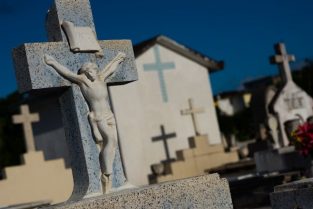Related Posts
One year after Hurricane Maria hits Puerto Rico, Florence strikes the Carolinas

The tombstone of Ricardo Garcia Delgado, who died Sept. 24, 2017, in Puerto Rico. (Sarah L. Voisin/The Washington Post)
Comprehending the death toll in Puerto Rico
Sept. 20 was the first anniversary of Hurricane Maria, which struck Puerto Rico as a powerful Category 4 storm and has left thousands of people still without power or with only intermittent service. After Hurricane Fran in September 1996, we lived without power for a week. That was a nightmare. A year is intolerable, especially for a place that is part of the United States. Puerto Ricans deserve better from the government in Puerto Rico and from the national government in Washington, D.C.
On the anniversary of the hurricane, Governor Ricardo Rosselló spoke to the press about an Aug. 29 report on fatalities, authored by faculty members at George Washington University’s Milken Institute School of Public Health, in collaboration with the University of Puerto Rico Graduate School of Public Health. Some, most notably President Trump, publicly questioned the report’s findings.
The study compared deaths in the period after the hurricane to mortality rates established in non-hurricane years. As a result, the authors concluded that the number of deaths attributed to the hurricane should not be 64, as claimed by the U.S. government, and initially accepted in Puerto Rico but rather, nearly 3,000, given deaths that occurred in the storm’s immediate aftermath and up to six months later.
The analysis was well done and the findings solid. The methods were appropriate and logical. As The Washington Post reported, “The spike in mortality came as the territory dealt with widespread and lengthy power outages, a lack of access to adequate health care, water insecurity and diseases related to the crisis.” As almost always occurs, the poor, sick, very old and very young, and vulnerable populations were affected adversely.
Michael Kosorok, PhD, W.R. Kenan Jr. Distinguished Professor and chair of our biostatistics department, was one of 34 biostatistics chairs across the country who signed an op-ed, published Sept. 30 in The Hill, reviewing the methodology and findings of the study.
The article supports the number of storm-attributable deaths estimated by the recent independent analyses of Maria’s impact in Puerto Rico and explains how statistics can save lives by supporting efforts to prevent and prepare for future disasters.
“Our nation’s approach to public health surveillance must be based on the collection of reliable representative vital statistics that do not reflect any premeditated political agenda,” the renowned biostatisticians write. “Safeguarding the integrity of this public health paradigm is vital to maintaining the health of our nation’s citizens.”
Governor Rosselló accepted the study’s findings and new statistics and promised to do better. Our government in Washington also should do better. Let’s move from politics to people. This is not the time for the White House to second guess science but to deliver on promises. For the people of Puerto Rico, time and patience understandably are running out.
Aftermath of Hurricane Florence
Now, thousands of people in North Carolina and South Carolina have their own hurricane aftermath, and for many, it will be a very long, hard recovery. Many of our students had to leave their families in upheaval so they could return to school. Across the University, we’re encouraging faculty members to be flexible and understanding.
People across the Gillings School are helping. A group within the School is meeting to understand the extent of needs and reach out to community partners. Kudos to faculty, staff and students at the Institute of Marine Sciences (IMS) in Morehead City, N.C., including Rick Luettich, Rachel Noble, Hans Paerl and Mike Piehler, who are dealing with damage to their work buildings, homes and communities. I spoke with Dr. Jill Stewart, associate professor of environmental sciences and engineering (ESE), about the situation, and Dr. Barb Turpin, ESE chair, reached out to faculty members at IMS; now, some of their students are here in Chapel Hill, working with our students to gather water samples, and Jill is teaching students from both locations, together. That’s what we should be doing. Barb and Jill are great exemplars for stepping up to help. Still, much more help is needed.
The UNC Institute of Marine Sciences (IMS) retweeted Patrick Gray, a doctoral student at neighboring Duke Marine Lab in Beaufort:
Made a video of #HurricaneFlorence's impact on @CapeLookoutNPS using @planetlabs satellite imagery. Stunning change in the Cape and a massive amount of organic matter out of Beaufort Inlet. These barrier islands are living and breathing and major storms sure do demonstrate that. pic.twitter.com/h0GychscpH
— Patrick Gray (@clifgray) September 23, 2018
I talked with people who had been back in their home only a short time, having had to restore it after Hurricane Matthew, which struck eastern N.C. in fall 2016. Now, their home is gone again. The traumatic effects of these storms are cumulative. They’re economic, emotional, physical. People will lose not only the physical structure of their homes, but also community, certainty, income, memories, stability, comfort, peace of mind, security, sometimes health and sometimes their lives. Most people who need it may not have flood insurance or are under-insured.
Two weeks after Florence, hundreds of roads remained closed across the state and NCDOT had identified more than 2,800 sites where roads needed repairs because of the storm. Classes at UNC-Wilmington still have not resumed and won’t until next Monday, Oct. 8.
Some places to give
Aid is needed in the form of volunteer labor, food, diapers and all kinds of supplies, services and monetary donations. The Carolina Center for Public Service at UNC-Chapel Hill has developed a Hurricane Florence disaster relief page containing an extensive list of places and ways to give. We all can help. Let’s do.
Barbara
